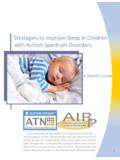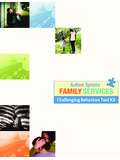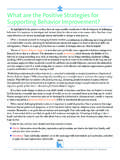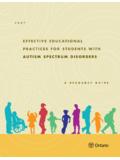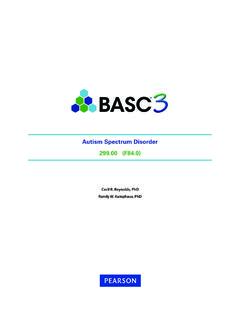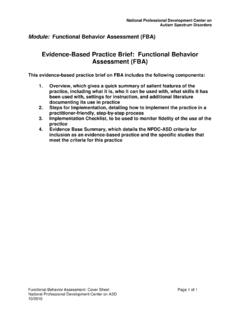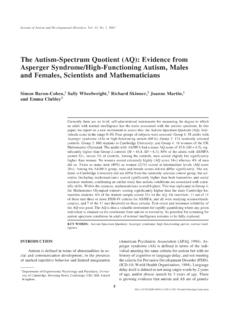Transcription of Parent’s Guide to Managing Constipation ... - Autism Speaks
1 Parent s Guide to Managing Constipation in Children with AutismThese materials are the product of on-going activities of the Autism Speaks Autism Treatment Network, a funded program of Autism Speaks . It is supported by cooperative agreement UA3 MC 11054 through the Department of Health and Human Services, Health Resources and Services Administration, Maternal and Child Health Research Program to the Massachusetts General Hospital. Its contents are solely the responsibility of the authors and do not necessarily represent the official views of the MCHB, HRSA, HHS, or Autism Speaks .
2 Overview of Constipationa. What is it?b. What causes Constipation ?c. Is Constipation harmful?Impaction and EncopresisDaily Treatment of ConstipationIncreasing Fiber in Your Child s DietIncreasing Fluid IntakeBowel Habit TrainingDaily Medicines for ConstipationMedicines for ImpactionHow to Give an EnemaStool DiaryTreatment Plan/Action children have Constipation . Children with Autism might have more problems with Constipation than other children. Difficulty with things like sitting on the toilet and eating different foods can make treating Constipation tool kit is to help parents manage Constipation in their children with Autism *.
3 *In this tool kit the term Autism will be used to describe children with all types of Autism spectrum disorders , including Autistic Disorder, Asperger s Disorder, and pervasive developmental Disorder, Not Otherwise Specified (PDD-NOS)Table of ContentsGuide for Managing Constipation in Children - An Autism Speaks ATN/AIR-P Tool Kitp. 1 Managing Constipation in Children1. WithholdingSome children hold their stool in and try to stop the urge to have a bowel movement. This may happen for many reasons, such as: fear of the toilet not wanting to use a different toilet not wanting to take a break from play worry that having a bowel movement will hurt2.
4 Toilet TrainingChildren resist and try to hold in stools when they are being toilet trained. Sometimes this becomes a habit. Habits can be hard to Diet ProblemsFiber: Not eating enough fiber, found in fruits, vegetables, and whole grains Dairy: An allergy to cow s milk or intake of too much dairy foods (milk, cheese) Water/Fluids: Not drinking enough water or other fluids, especially when sickIllness: Changes in a child s appetite or diet because of illness4. Changes in RoutineTravel, hot weather or stress can affect the way bowels MedicationSome medicines, such as antacids, antidepressants and some ADHD drugs can cause hard Medical ConditionsChildren who have difficulty using their muscles, have low muscle tone or have Cerebral Palsy can have problems with Constipation .
5 Other medical conditions such as problems with gluten or casein could first be identified because of causes Constipation ? Constipation is when a child has: Hard stools Pain or trouble passing stool Less than three stools per weekWhat is Constipation ?TAlk TO YOuR CHIlD S DOCTOR OR nuRSE . HE/SHE CA n HE lP YO u knOW IF YOuR CHIlD HAS (not all) children with Constipation have this problem. Impaction is when a child has a large, hard stool in the colon.
6 This makes it hard for the child to pass stool. Your child s doctor or nurse can feel it by pressing on the lower stomach or by looking at an x-ray. Many children with impaction have a loss of appetite and are less interested in physical activity. After passing the stool, the child feels better and symptoms (not all) children with Constipation have this problem. Encopresis is the leaking of liquid stool in a child who is constipated.
7 This is a common problem. Encopresis develops when a child holds stool and it becomes difficult to pass. The stool becomes larger and more dried out. When large stools are held in the rectum, the rectal muscles become tired and relaxed. When these muscles relax, liquid stool can ooze around the large stool mass and leak into the underwear. The child does not feel the passage of this liquid stool and has no control over this.
8 It can happen many times during the day and result in dirty underwear. Sometimes people confuse this with diarrhea. This is not diarrhea because most of the stool in the bowel is children who have encopresis have a loss of appetite and are less interested in physical activity. After passing the stool, the child feels better and symptoms for Managing Constipation in Children - An Autism Speaks ATN/AIR-P Tool Kitp. 2 Impaction and Encopresis Treatment of Constipation focuses on three main areas.
9 Talk to your child s doctor or nurse to know if these treatments are right for your child: Increasing fiber in the diet will add bulk to the stool and make it easier to pass. Giving more fluids, especially water and juice, will help soften the stool and help with to page 4 for more information Regular Exercise Physical activity helps the muscles in the belly to move stool through the large bowel. Regular activity such as walking, jumping rope, playing tag, riding a bike, and swimming will help with Constipation .
10 Bowel Habit Training It is important for a child to use the toilet as soon as he feels the urge to go. The best way to teach this is to have regular toilet sitting times. Go to page 7 for more information Medicine is often needed to help children have regular, soft bowel movements. Daily medicines are used everyday. Clean out medications are used only when a child has a large stool that is hard to to page 11 for more information1. Diet Changes2. Behavior Changes3. MedicineGuide for Managing Constipation in Children - An Autism Speaks ATn/AIR-P Tool kitp.






